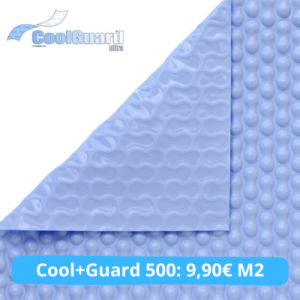GeoBubble Pool Covers:

Do you have a pool at home? Do you love immersing yourself in refreshing and relaxing waters? If so, you surely know how important it is to keep your pool in the best condition. But what if I told you there’s a smart solution that not only protects your pool but also helps you save time and energy? GeoBubble covers are the answer! In this article, we will explore everything about these innovative covers: what they are, why they are essential, their advantages, and the quality options available, such as Energy+Guard 500 microns, Sol+Guard 500 microns, and Reinforced 700 microns.
What Are GeoBubble Covers and Why Are They Essential for Your Pool
GeoBubble covers are much more than simple protection layers for your pool. They are designed to make your aquatic experience more enjoyable and worry-free. These covers feature a unique pattern of geometric bubbles, known as “geo-bubbles,” which not only add a touch of style but also serve a key purpose. These bubbles are specially designed to efficiently trap solar heat, maintaining the water temperature and reducing evaporation.
Advantages of GeoBubble Covers:
Temperature Conservation: If you love enjoying the water at the perfect temperature, GeoBubble covers are your ideal allies. The geo-bubbles act as small heat traps, capturing sunlight and preventing heat dissipation. This means you can immerse yourself in a pool of warm water without worrying about constant cooling.
Evaporation Reduction: There’s no doubt that water evaporation is a challenge for any pool. GeoBubble covers act as an effective shield, reducing evaporation and conserving water in the pool. This saves you time and money by minimizing the need to constantly replenish lost water.
Protection Against Dirt and Debris: Geo-bubbles not only serve a thermal function but are also excellent at keeping your pool free of dirt and debris. You no longer have to deal with floating leaves and debris, simplifying maintenance and providing you with a cleaner swimming area.
Quality Options for Your Needs:




Energy+Guard 500 Microns: If you’re looking for a durable and energy-efficient cover, the Energy+Guard model with 500 microns is an excellent choice. With its optimal thickness, this cover offers solid protection and superior heat retention.
Sol+Guard 500 Microns: Want the best of both worlds? The Sol+Guard model with 500 microns combines style and functionality. In addition to its resistance to evaporation and temperature maintenance, this cover adds an aesthetic touch to your pool.
Reinforced 700 Microns: If you’re seeking robust and long-lasting protection, the Reinforced cover with 700 microns is your ideal choice. With its greater thickness, this cover is designed to withstand adverse weather conditions and provide a reliable barrier against external elements.
Do you want to receive a quote
Contact us and specify the approximate pool dimensions, the city where you are located, and the type of cover you are interested in.
We will search for the best prices and the highest quality for you.
How to Measure Your Pool for the Perfect GeoBubble Cover

Ensuring you choose the right GeoBubble cover for your pool starts with precise measurements. Here’s a quick guide on how to measure your pool in a few simple steps:
Length and Width: Use a tape measure to measure the length and width of your pool from the inside of the edge. Start from one end and measure to the other, making sure to include any irregular shapes. Note these measurements in meters.
Pool Shape: If your pool has a non-standard shape, such as an L shape or a curve, make sure to measure each section individually. Then, add up the resulting areas to get the total pool area.
Depth: Measure the depth of your pool at various points, such as the deepest and shallowest ends. This will give you a general idea of the average depth.
Edges and Features: Consider any additional features in your pool, such as stairs, raised edges, or protruding areas. Measure these areas separately and add their dimensions to the total area.
Round Measurements: Always round the measurements to the nearest number to obtain precise figures.



![20200930_123447_HDR[1] 20200930_123447_HDR[1]](https://cuidatupiscina.com/wp-content/uploads/elementor/thumbs/20200930_123447_HDR1-scaled-qfp3x9kp5ktt81kszthtfcsur816069u0y03b2ebaw.jpg)
